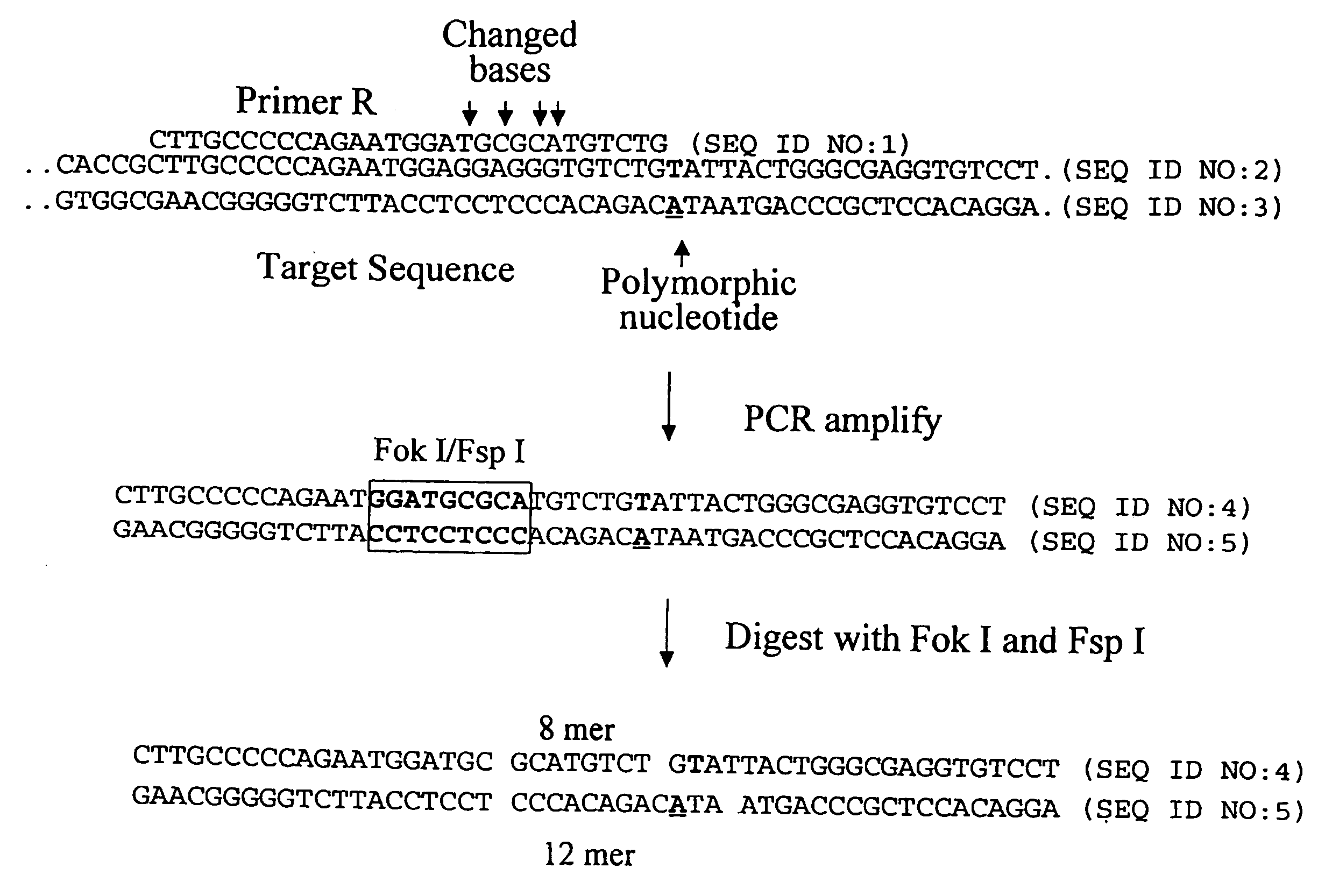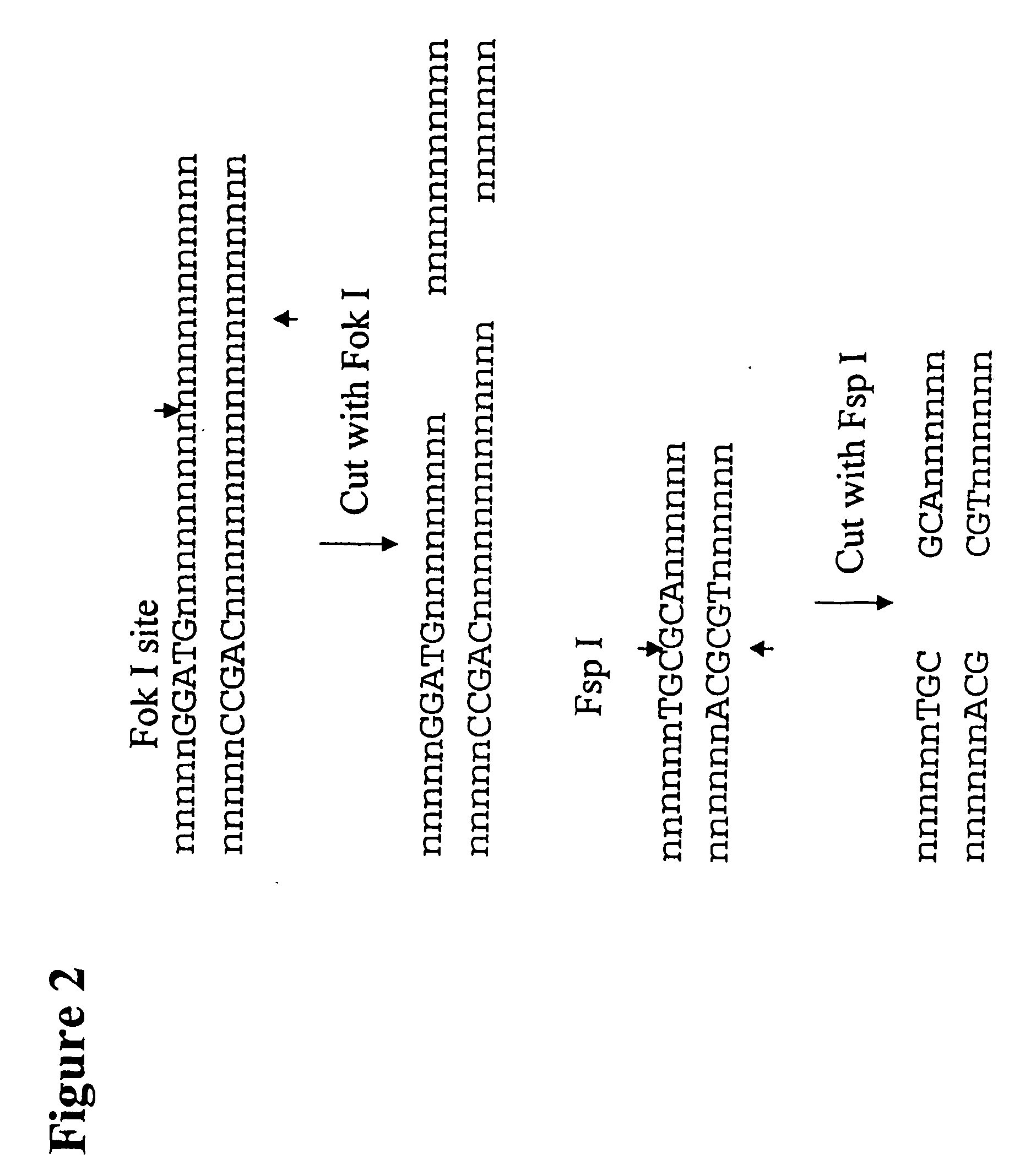Methods for genetic analysis of DNA to detect sequence variances
a technology of dna and genetic analysis, applied in the field of genetic analysis of dna to detect sequence variance, can solve the problems of high accuracy, cumbersome available haplotyping methods, unproven or inadequate accuracy, etc., and achieves easy and robust analysis, effective amplification, and easy production
- Summary
- Abstract
- Description
- Claims
- Application Information
AI Technical Summary
Benefits of technology
Problems solved by technology
Method used
Image
Examples
example 1
Haplotyping Method Using Hairpin Inducing Primers for Allele Specific PCR
[0255]A primer is designed which contains at least two different regions. The 3′ portion of the primer corresponds to the template DNA to be amplified. The length of this region of the primer can vary but should be sufficient to impart the required specificity to result in amplification of only the region of cDNA or genomic DNA of interest. Additional nucleotides are added to the 5′ end of the primer which are complementary to the region in the sequence which contains the nucleotide variance. Following two rounds of PCR, the added tail region of the primer is incorporated into the sequence. Incorporation of the added nucleotides causes the reverse strand complementary to the primer strand to form a hairpin loop if the correct nucleotide is present at the site of variance. The hairpin loop structure inhibits annealing of new primers and thus further amplification.
[0256]Primers with the above characteristics were...
example 2
Genotyping of an ApoE Variance by Mass Spectrometry Analysis of Restriction Enzyme Generated Fragments
[0262]The following example describes the genotyping of the variance at genomic site 21250 in the ApoE gene which is a T:C variance resulting in a cysteine to argininine amino acid change in amino acid 176 in the protein. Two primers were designed to both amplify the target region of the ApoE gene and to introduce two resctriction enzyme sites (Fok I, Fsp I) into the amplicon adjacent to the site of variance. FIG. 40 shows the sequence of the primers and the target DNA. The Apo21250-LFR primer is the loop primer which contains the restriction enzyme recognition sites and the ApoE21250-LR primer is the reverse primer used in the PCR amplification process. The polymorphic nucleotide is shown in italics. The following components were mixed together in a 200 μl PCR tube for each genotyping reaction. All volumes are given in μl.
A.10x PCRx buffer (Gibco / BRL, cat# 11509-015)2B.2 mM dNTP mi...
example 3
Screening the ApoE Gene for Polymorphism
[0263]PCR primers were selected automatically by a computer program that attempts to match forward and reverse primers in terms of GC content, melting temperature, and lack of base complementarity. The parameters of the program were set to select primers approximately 500 base pairs apart from each other, with at least 50 base pairs of overlap between adjacent PCR products. Primers were received in 96 well microtiter plates, resuspended in sterilized deionized water at a concentration of 5 pmoles / ul. PCR reactions were set up using a programmed Packard robot to pipet a master mix of 1×PCR buffer, polymerase and template into 96 well plates. Starting PCR conditions were: 10 mM Tris (pH 8.3), 50 mM KCl, 1.5 mM MgCl2, 0.2 mM dNTPs, 0.83 uM forward and reverse primers, 0.7 Units of AmpliTaq Gold (PE Corp) and 25 ng of genomic template, in a volume of 30 ul. Cycling was done on MJ PTC200 PCR machines with the following cycle conditions: denature 12...
PUM
| Property | Measurement | Unit |
|---|---|---|
| melting temperature | aaaaa | aaaaa |
| mass | aaaaa | aaaaa |
| volume | aaaaa | aaaaa |
Abstract
Description
Claims
Application Information
 Login to View More
Login to View More - R&D
- Intellectual Property
- Life Sciences
- Materials
- Tech Scout
- Unparalleled Data Quality
- Higher Quality Content
- 60% Fewer Hallucinations
Browse by: Latest US Patents, China's latest patents, Technical Efficacy Thesaurus, Application Domain, Technology Topic, Popular Technical Reports.
© 2025 PatSnap. All rights reserved.Legal|Privacy policy|Modern Slavery Act Transparency Statement|Sitemap|About US| Contact US: help@patsnap.com



